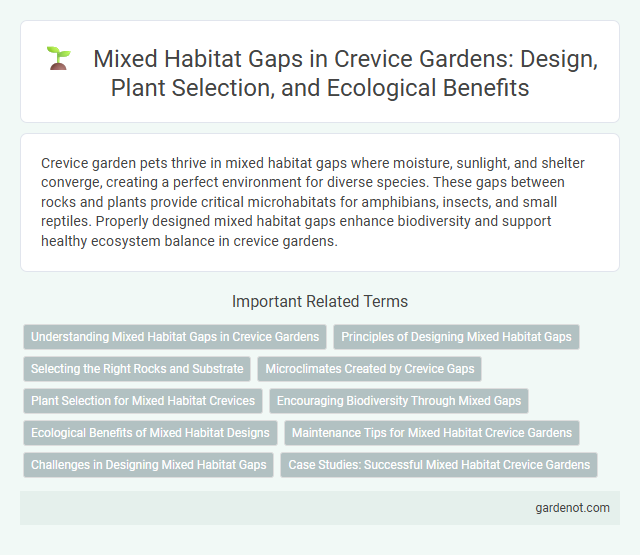Crevice garden pets thrive in mixed habitat gaps where moisture, sunlight, and shelter converge, creating a perfect environment for diverse species. These gaps between rocks and plants provide critical microhabitats for amphibians, insects, and small reptiles. Properly designed mixed habitat gaps enhance biodiversity and support healthy ecosystem balance in crevice gardens.
Understanding Mixed Habitat Gaps in Crevice Gardens
Mixed habitat gaps in crevice gardens create crucial microenvironments where diverse plant species with varying moisture and light requirements coexist. These gaps enhance biodiversity by allowing moisture retention in shaded crevices and increased sunlight exposure on rocky surfaces, promoting a balanced ecosystem. Understanding the spatial distribution and interplay of these gaps supports optimal planting strategies to maximize ecological benefits and sustainability.
Principles of Designing Mixed Habitat Gaps
Effective design of mixed habitat gaps in crevice gardens incorporates diverse plant species that thrive in varying microclimates within the gaps, promoting biodiversity and resilience. Strategic placement of plants with different root depths and moisture requirements enhances ecological balance and resource utilization. Emphasizing native and drought-tolerant species supports sustainable growth and minimizes maintenance efforts in crevice environments.
Selecting the Right Rocks and Substrate
Selecting the right rocks and substrate is crucial for creating a successful crevice garden, ensuring proper drainage and mimicking natural conditions. Use durable, weather-resistant stones such as granite or limestone paired with a well-draining substrate like gritty sand mixed with organic compost. This combination supports diverse plant roots, prevents waterlogging, and promotes healthy growth within mixed habitat gaps.
Microclimates Created by Crevice Gaps
Crevice gardens create unique microclimates by forming narrow gaps that retain moisture and moderate temperature fluctuations, supporting diverse plant species adapted to these conditions. These mixed habitat gaps provide shelter from wind and extreme weather, fostering environments where drought-resistant and shade-tolerant plants thrive side by side. The microclimates within crevice gaps enhance biodiversity by creating distinct ecological niches not found in conventional garden settings.
Plant Selection for Mixed Habitat Crevices
Selecting drought-tolerant succulents like Sedum and Sempervivum enhances mixed habitat crevice gardens by thriving in minimal soil and water conditions. Including native wildflowers such as Eriogonum and Penstemon supports local pollinators and promotes biodiversity within crevice microhabitats. Incorporating a variety of root depths and growth forms ensures optimal space utilization and soil stabilization in crevice gardens.
Encouraging Biodiversity Through Mixed Gaps
Crevice gardens with mixed habitat gaps create a diverse microenvironment that supports various plant species and thriving pollinator populations. Integrating different soil types, moisture levels, and planting niches within these gaps enhances ecological niches, promoting higher biodiversity. These mixed gaps mimic natural rocky landscapes, fostering resilience and sustainability in the garden ecosystem.
Ecological Benefits of Mixed Habitat Designs
Mixed habitat designs in crevice gardens create diverse microenvironments that support a wide range of flora and fauna, enhancing local biodiversity. These gap-filled structures provide critical shelter and resources for pollinators, birds, and beneficial insects, promoting ecological balance. The integration of varied plant species within the crevices enhances soil health and resilience against pests, contributing to sustainable ecosystem functioning.
Maintenance Tips for Mixed Habitat Crevice Gardens
Regular inspection and removal of invasive weeds prevent competition in mixed habitat crevice gardens, ensuring native plants thrive. Targeted watering conserves moisture in crevices without oversaturation, supporting drought-tolerant species. Seasonal pruning and debris clearance enhance airflow and light penetration, promoting healthy growth in diverse plant assemblages.
Challenges in Designing Mixed Habitat Gaps
Designing mixed habitat gaps in crevice gardens presents challenges such as ensuring compatibility between diverse plant species with varying moisture and light requirements. Limited space within crevices demands careful selection of drought-tolerant and shade-adapted plants to prevent competition and promote biodiversity. Soil composition and drainage must be optimized to support multiple habitat types while maintaining structural stability in the garden.
Case Studies: Successful Mixed Habitat Crevice Gardens
Case studies of successful mixed habitat crevice gardens demonstrate the importance of combining diverse plant species to replicate natural ecosystems, enhancing biodiversity and resilience. For instance, the crevice gardens at the Royal Botanic Gardens Edinburgh feature a blend of alpine succulents, ferns, and mosses thriving in narrow fissures, showcasing optimal microclimates for moisture retention and root anchorage. These case studies emphasize species selection based on native habitat conditions, soil composition, and sun exposure to create sustainable, low-maintenance crevice garden models.
Mixed habitat gap Infographic

 gardenot.com
gardenot.com